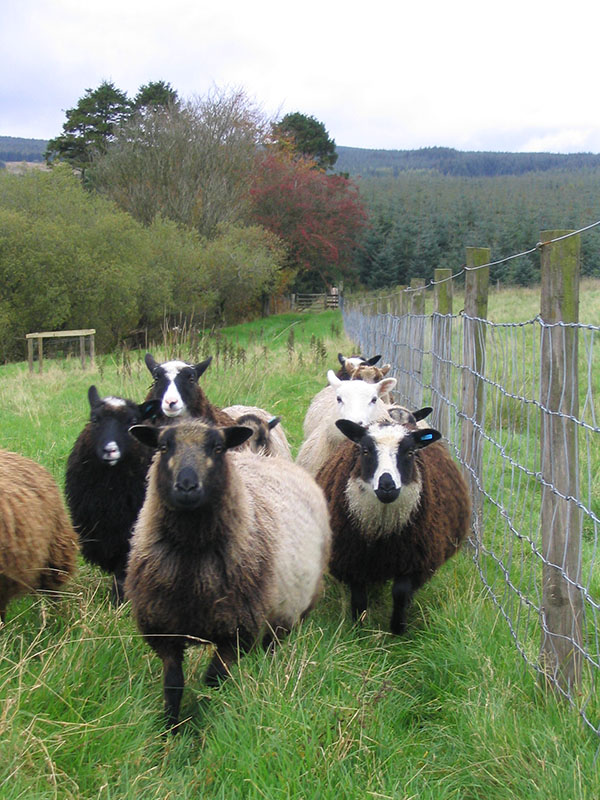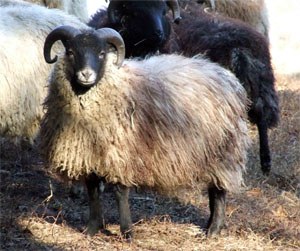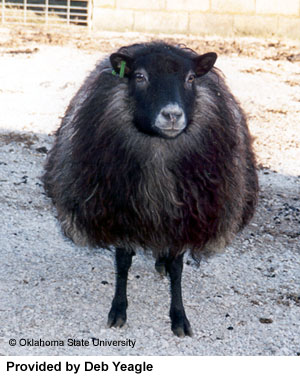Shetland Sheep
The Shetland's roots go back over a thousand years, probably to sheep brought to the Shetland Islands by viking settlers.
They belong to the Northern European short-tailed group which also contains the Finnsheep,
Norwegian Spaelsau, Icelandics, Romanovs and others.
a thousand years, probably to sheep brought to the Shetland Islands by viking settlers.
They belong to the Northern European short-tailed group which also contains the Finnsheep,
Norwegian Spaelsau, Icelandics, Romanovs and others.
The Shetland is the smallest of the British breeds and it retains many of the characteristics of wild sheep. Today they are considered a primitive or "unimproved" breed. Rams usually weigh 90-125 lbs and ewes about 75-100 lbs. Rams usually have spiral horns, whereas the ewes are typically polled. They are fine-boned and their naturally short, fluke-shaped tails do not require docking.
Shetland Wool
Shetland wool has a Bradford count usually in the upper 50's to lower 60's and a fiber diameter range of 20-25 microns. Fleeces usually weigh between 2-4 lbs (1-1 .5 kg) and have a staple length of 2-4.5 inches (50-120 mm).
 Shetland comes in one of the widest ranges of colors of any breed. Besides the white,
the sheep produce several shades of wool including moorit(reddy/brown), shaela (silvery
gray), fawn, gray, dark brown and black. They are often patterned such as krunet (white
crown), katmoget (dark belly) and gulmoget (light underneath). There are 11 main colors
as well as 30 markings, many still bearing their Shetland dialect names. Unfortunately,
many of these colors and markings have become quite rare as white wool has historically
commanded better prices.
Shetland comes in one of the widest ranges of colors of any breed. Besides the white,
the sheep produce several shades of wool including moorit(reddy/brown), shaela (silvery
gray), fawn, gray, dark brown and black. They are often patterned such as krunet (white
crown), katmoget (dark belly) and gulmoget (light underneath). There are 11 main colors
as well as 30 markings, many still bearing their Shetland dialect names. Unfortunately,
many of these colors and markings have become quite rare as white wool has historically
commanded better prices.
The wool color and high quality is commercially important to the wool industry of the islands where natural wools are often used undyed to make high quality shetland knitwear. Extra fine ring shawls are knitted, so called because the finest can be passed through a wedding ring. In the UK as a whole the wool is prized by handspinners.
Shetland sheep are very hardy, good mothers, easy lambers and produce plenty of milk. When crossed with an early maturing terminal sire (such as a Ryeland) the fat lambs make excellent eating and dress out well. Purebred Shetland meat is highly regarded on taste, but is slow to mature and wethers are often run through to shearlings.
 The breed society for the Shetland Islands is the Shetland Flock Book Society. On
the mainland UK the Shetland Sheep Breeders Group (SSBG) act as the breed society
and also have foreign members (mainly US). Both groups are based on the breed standard
set in the 1920s.
The breed society for the Shetland Islands is the Shetland Flock Book Society. On
the mainland UK the Shetland Sheep Breeders Group (SSBG) act as the breed society
and also have foreign members (mainly US). Both groups are based on the breed standard
set in the 1920s.
In the US the North American Shetland Sheep Breeders Association (NASSA) was established in coordination with the Shetland Sheep Breeders' Group of the Rare Breeds Survival Trust in the UK. The purpose of the association is to assist breeders of Shetland Sheep in North America in maintaining the purity and quality of the breed and to provide accurate registration and pedigree records for informed breeding decisions.
The number of pedigree animals is approximately 2,000 breeding ewes in the UK which is an increase over the last ten years. They are now classed as a minority breed under the Rare Breeds Survival Trust (RBST) having previously been a rare breed.
Registries and Breed Associations
United Kingdom
Mr. Jim Johnson, Secretary
The Shetland Flock Book Society
Fairview
Vidlin Shetland
01806 577227
Registration and Membership Secretary: Peter Hardman
Acre Cottage
Horsebridge
King's Somborne
Hampshire, SO20 6PT, United Kingdom.
Tel: (+44) 1794-388057
Email: hdvq@huraix.hursley.ibm.com
United States
North American Shetland Sheep Breeders Association
NASSA Registrar
PO Box 842
Jamul, CA 91935-0842
Fine Fleece Shetland Sheep Association
References
Paul Wilson, UK.
Email: paul@farm.u-net.com
North American Shetland Sheep Breeders Association, P.O. Box 842, Jamul, CA 91935-0842
